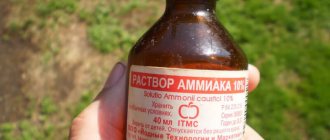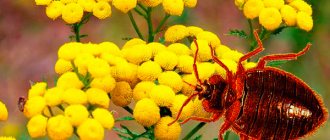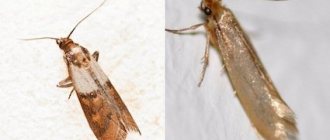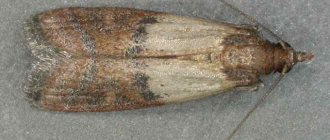How to use
If tansy for moths is chosen, the housewife herself must decide how to use this herbal remedy. The method of application may differ depending on what kind of moth needs to be removed: kitchen or clothes moth.
In addition, before using tansy against pests, all recommendations for storage rules for food and clothing must be followed.
Dry grass
Application may vary depending on the time of year. In the summer, to get rid of food moths on kitchen shelves, it is recommended to lay out bunches of fresh, recently picked plants. After 7-9 days, it is advisable to replace the already wilted grass with fresh one. In winter, housewives use dry grass.
Tansy is placed in clothing pockets, but keep in mind that dry grass is fragile and, when damaged, forms a lot of small debris, which has to be systematically removed. To get rid of moths in an apartment, a clothes sachet is made from a dry plant. To do this, sew a small bag of fabric and fill it with dry tansy.
To enhance the effect, add lavender, thyme or wormwood. The combination of such odors effectively repels moths.
Decoction
Moth tansy can also be used as a decoction. To prepare such a remedy for moths, take a glass of herbs and boil it in a water bath in 5 liters of water. Then they let the product settle, filter it and use it to wash the shelves in the closet (kitchen or linen).
It is also advisable to add the decoction when washing floors or use a trigger to spray the solution around the room to create a concentrated smell of a natural repellent.
Tincture
Some people prefer to make tinctures from tansy. For 500 ml of vodka or medical alcohol, take 20 g of dry plant. Leave in a dark place for 24 hours. The owner’s imagination will tell her how to use alcohol tincture for tansy. Some people drip a few drops of this product onto a case for storing a fur coat or other fur products. Or add 15-30 ml of this product to the water when doing a thorough cleaning in the apartment or on the shelves of the kitchen cabinet.
Precautionary measures
Finding a hole in a mink coat or spoiled grain is an unpleasant surprise for any housewife. To prevent the appearance and reproduction of harmful butterflies, the necessary measures should be taken in a timely manner:
- Check flour, cereals, pasta, dried fruits, cookies, nuts that are stored in kitchen cabinets and pantries. If you find small white eggs or yellow caterpillars with a brown head, throw away the contaminated food.
- Food moths are afraid of temperature fluctuations. The food kitchen larva is hatched by heating the cereals in the oven at a temperature of +70...+80°C for 20-25 minutes. Freezing to -10°C acts more slowly - death occurs after 3 days.
- Review your wardrobe. Insects do not attach well to tissues. Therefore, you need to go through and shake all things, especially those that have not been worn for a long time. Clothes that are moth-eaten should be thrown away.
- To combat a pest in a clothing closet, you should consider the temperature at which the moth dies. In winter, clothes are taken out into the cold, in summer - into the sun. Caterpillars and pupae die in a couple of hours at -10°C, in hot sunny weather - after 5-6 hours.
- Beat out or vacuum carpets, shake blankets, bedspreads, and feather pillows and place them in the sun.
A small gray butterfly that flies around the apartment brings big problems to its residents. To prevent the appearance of moths, it is necessary to keep the room clean and regularly inspect cabinets and dressing rooms. If an insect does settle in the house, simple, proven and reliable folk remedies will come to the rescue.
Efficiency
To understand whether tansy helps against moths, you should first remember that this plant is a repellent, not an insecticide. This herb, like any other repellent, is an effective preventative. With its active use, tansy protects the living space from the penetration of pests.
If there are already too many fluttering parasites and their larvae, then folk recipes alone will not get rid of them.
In this case, it is necessary to use chemical insecticides.
Plants growing in the wild
Plants that repel moths
If you ask any housewife the name of the plant that is most often used against moths, each will answer - it is lavender, which has a very strong and pleasant smell. In nature, it grows in the Mediterranean region, in the southern regions of Russia; some gardeners also grow it in the middle zone. Its advantage is that the aroma remains preserved for a long time, and the effectiveness of dry flowers or essential oil on moths is almost the same. It is widely used in industry, cosmetics and perfume production.
Advantages and disadvantages
Moth tansy helps repel pests and has the following benefits:
- not dangerous to human health (but if too much of it is decomposed, it can cause headaches and disturbances in spatial orientation);
- is a natural air flavoring agent;
- You can prepare it yourself or purchase it at a pharmacy for a low fee.
But the disadvantage of tansy is that it is not an effective moth repellent, since it only repels, but does not kill, the pest. If a pest accidentally finds itself in a living space, then with the rich aroma of tansy, it will strive to leave it as quickly as possible.
In addition, tansy does not affect moth larvae, since they do not perceive odors and are not afraid of them.
If the room is heavily infected, then the use of tansy is not justified, and it will not give the desired result.
Video
What contraindications does tansy have?
Benefits of folk remedies against moths
Many housewives believe that it is easier to prevent the gray guest from entering the house by placing dry plants in the closets that emit a pungent odor (wormwood, lavender, geranium, cloves, walnut branches). If a white, inconspicuous butterfly flies around the house, then it is better to use folk remedies. They have advantages over chemicals:
- do not contain toxic components and insecticides, therefore, when treating cabinets and mezzanines, household members do not have to leave the rooms;
- the costs of removing the uninvited guest will be small;
- you don’t need to go to specialized stores to buy folk remedies (just go out into the garden or look at the kitchen shelf: every home has many components that will be effective in fighting moths);
- home remedies are highly environmentally friendly; humans do not experience any side effects from their use.
All remedies against gray moths have one drawback: their action is long-lasting, and the result is not immediately visible.
Interesting to know! About thirty species of moths are known. The moths flying around the house are males and do not cause any harm. Females that lay eggs hide in secluded places. It is necessary to fight them, otherwise the eggs will hatch into larvae, and then caterpillars, which will begin to take over the mezzanines and kitchen tables.
Other herbs
Essential oils provide a strong aroma to many plants. This natural compound can accumulate in different parts: flowers, leaves, roots, fruits, seeds. Different parts of the same plant may contain different concentrations of essential oils.
To achieve maximum repellent effect on pests, you need to know exactly the most effective part of the plant.
Repellents of plant origin are found everywhere: in meadows, fields, flower beds near houses. Some people have plants with this effect growing on their windowsill at home.
Among the strong-smelling herbs against moths, the following are popular:
- Sagebrush. To combat insects, use the above-ground part of wormwood, which is dried in well-ventilated areas without direct sunlight. Bouquets of wormwood or fabric bags filled with raw materials are placed inside bags of woolen products, on closet shelves or in fur coat pockets. Essential oils evaporate over time, so wormwood preparations need to be changed periodically. Flower growers have also developed varieties of decorative wormwood that retain repellent properties and also have an attractive appearance.
- Lavender. A very strong, pleasant lavender scent lasts a long time and can repel adults as well as larvae. Sprigs of dried lavender are laid out in fabric bags and placed in the closet between things. The more there are, the more effective the result will be. House moths cannot stand the smell of lavender and tend to quickly leave the room.
- Sweet clover. Sweet clover is also popular among housewives. The flowers of this plant contain a large amount of coumarin, giving them a pleasant, persistent aroma. Dry preparations of this plant are poured over clothes or filled into sachets and laid out on closet shelves.
- Oregano. Dry oregano in a ventilated place, not in the sun, spreading it on a cloth in a loose layer and stirring several times a day. The second option is to hang bunches of oregano in a place protected from direct sunlight and drafts. Then the branches with inflorescences are sewn into a gauze bag and hung between fur coats and woolen products. Oregano will not only protect things from damage, but will also give them a pleasant original aroma.
- Chamomile. Adults and larvae are afraid of the smell of chamomile. Based on powder from crushed flower baskets, insecticidal preparations are produced to combat household insects. Adding a small amount of extract to the water when rinsing will protect woolen items from pests. Pyrethrum is used to make fabric pads filled with fragrant powder.
- Marsh rosemary. For moths, dried crushed flowers are used and at the same time wild rosemary sprigs are laid out on the shelves. For flying butterflies, fumigation of plant leaves with powder is used.
In addition to dry herbs, some decorative indoor plants (geranium, myrtle, plectranthus) also effectively repel insects. It is also recommended to grow aromatic herbs in pots - sage, rosemary, mint. They will provide protection from moths throughout the year.
If the house is clean, dry and the room is often ventilated, then moths are extremely rare. Following simple rules for storing things or food supplies will eliminate the risk of pest infestation. And tansy grass, used for preventive purposes, further guarantees protection against the pest.
Getting Close to the Enemy
Clothes and food moths The family of true moths (Tineidae) has 2000-3000 species. These butterflies are found everywhere, eating dry mushrooms, grains, and keratin-containing animal remains (fur, wool, fluff, feathers). You can meet representatives of the family in animal burrows, bird nests, and bat caves. But for humans, the most unpleasant roommates are clothing, fur, carpet and food moths, the varieties of which prefer to live in the kitchen: grain, fruit, flour.
Interesting!
A reliable fact is described when a moth ate dried snake venom without harm to itself. There are legends about the omnivorous nature of the moth, but it only eats those things or products where colonies of mold fungi are found.
Repellent plants do not kill insects, but repel them with their smell. Moths have many sensilla on their antennae and even front legs - olfactory elements that can detect odors in the slightest concentration. The sensitivity of the olfactory organ in butterflies is 100 times greater than that of humans. Therefore, a strong smell can repel insects from a closet with clothes or cereals.
Butterflies flying in the apartment are mainly males. Females prefer to hide in the folds of clothing and crawl from thing to thing. The imago is an adult insect that does not spoil food or tissue, since its digestive organs and oral apparatus are reduced. The main enemy is the moth larva. Its developed jaws allow it to gnaw holes even in plastic bags that protect things.
Fragrant tobacco
Tobacco is another effective folk method against gray butterflies. Fragrant tobacco is usually used as a houseplant, but as for smoking tobacco, it is better to use it in the form of small dry leaves, as in the cigarettes we are used to.
Place regular tobacco in bags and place inside pieces of furniture. Don't forget to ventilate your wardrobe periodically.
Attention! Do not use tobacco to protect clothing from moths. Things soaked in it will lose their attractiveness.
Fumigators
A fumigator is a special device that contains a poisonous liquid for insects inside the bottle. When you plug in the fumigator, the smell spreads throughout the entire apartment. The smell is not strong and quite tolerable. The insects die within a few days.
Safe for children, animals and adults.
Fumigator Dick 3
Fumigator Dick.
An inexpensive and very effective device that appeared quite a long time ago. The rest of the fumigators were made according to the Dick 3 type.
Previously, it was thought that the poisonous aroma only killed mosquitoes, but it turned out that this remedy also works on moths. The substance can be in a liquid state or in the form of plates. After plugging in the Dik 3 fumigator, a poisonous odor begins to be produced that is destructive to moths. The device itself consumes little energy.
Fumigator Mosquitall
It costs more than other devices, although the efficiency is the same as that of other fumigators. Costs about 300 rubles. Kills insects, mosquitoes and moths quickly and effectively.
Fumigator Raid
Fumigator Raid.
The box contains not only the Raid fumigator, but also mosquito repellent plates. The smell from the plates is also detrimental to moths. This device has several special functions: intensity regulator and timer.
Of course, because of these properties, the fumigator costs 160-310 rubles. The efficiency is the same as the Dick 3 fumigator.
Essential oils
Essential liquids are an excellent and very effective folk remedy for repelling pests.
fir, eucalyptus, rosemary oil, as well as patchouli, lemongrass and citronella oil are actively used .
Mode of application:
- Rinse the floor with water, after adding a few drops of essential liquid;
- Wipe the shelves and surfaces where moths may accumulate with oil;
- Lay out the swabs soaked in liquid;
- Spray cabinets and rooms;
- Place open bottles of anti-pest oils in wardrobes, kitchen cabinets and bedside tables.











